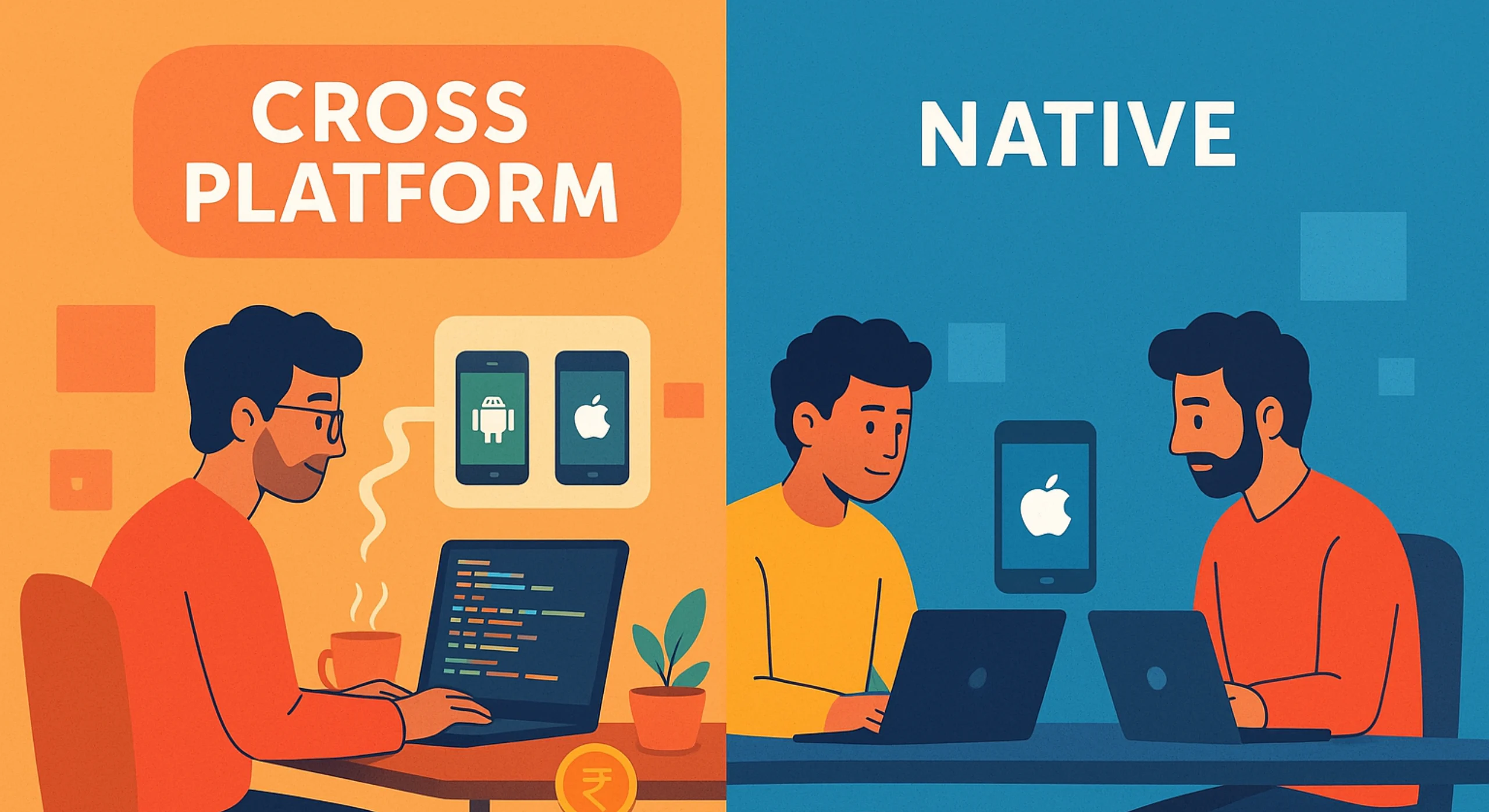Cross-Platform vs Native App Development – Which One Should You Bet Your Money On?

In the bustling world of mobile apps, every great idea starts with a crucial decision. The big question on everyone’s mind is a battle of efficiency versus specialization: cross platform vs native app development. One path involves building a single app that works on both Android and iOS, while the other means creating a separate, dedicated app for each platform. This fundamental choice influences everything from your budget and timeline to the performance and user experience of your final product. This article will help you quickly understand the core differences so you can make the right call for your project.
What Is Native App Development? – The Royal Route
Native app development means building an app specially for one platform, either Android or iOS. It’s like getting a tailor-made sherwani or lehenga stitched just for you. The fit is perfect, the fabric is high quality, and every detail is polished.
Pros of Native App Development:
- Best Performance – Since the app is made with the platform’s own language and tools, it runs fast and smooth, like a Rajdhani Express on time.
- Great User Experience – It looks and feels exactly like what Android or iOS users expect.
- Full Access to Features – Camera, GPS, Bluetooth, sensors, everything works without restrictions.
- Better Security – Platform-specific tools offer tighter security.
Cons of Native App Development:
- Double Effort – One app for Android, another for iOS.
- High Cost – You need two development teams or at least developers skilled in both platforms.
- Longer Time to Market – Twice the work means it takes longer to launch.
Native is the royal route it’s premium, classy, and high-performing. But as the saying goes, “Achhe cheez ka daam bhi achha hota hai” (Good things come at a price).
What Is Cross-Platform App Development? One Arrow, Two Targets
Cross platform app development is like cooking one big pot of biryani and serving it to guests from both Hyderabad and Lucknow same base, served to different tastes. You write a single codebase using frameworks like Flutter, React Native, or Xamarin, and it runs on both Android and iOS.
Pros of Cross-Platform Development:
- Cost-Effective – One team, one codebase your wallet will thank you.
- Faster Delivery – Develop once, launch everywhere.
- Easier Maintenance – Updates and bug fixes apply to both platforms at once.
- Growing Performance Quality – Modern frameworks are closing the gap with native performance.
Cons of Cross-Platform Development:
- Slight Performance Gap – Heavy gaming or 3D apps might not feel as smooth as native.
- Limited Access to Advanced Features – Some device-specific features may need extra coding.
- Design Adjustments Needed – UI might not feel 100% natural for each platform.
This is the “value-for-money” option quick, affordable, and good enough for most use cases. In India, where startups often have to do “kam paisa, zyada kaam” (more work with less money), it’s a lifesaver.
The Indian Market Twist
India is a unique market. We have Android dominating with over 90% share, but iOS users tend to be higher-spending customers. So when it comes to cross-platform vs native app development, you can’t ignore either side if you want the full pie.
- For Startups – Cross platform is usually the better start. It helps you test the waters without spending lakhs on two separate apps.
- For Enterprises – If performance, brand image, and platform-specific perfection matter, native often wins.
Take an example: a local food delivery startup in Pune might start with Flutter to launch quickly and serve both Android and iOS customers. But as they grow, they may invest in separate native apps for better speed, features, and branding.
When Native Development Makes Sense in India
- High-Performance Needs – Gaming apps, AR/VR apps, fintech apps with heavy calculations.
- Brand-Critical Apps – If your app is your main product (like Ola, Swiggy, or Paytm), you want top-notch performance and stability.
- Deep Device Integration – If you need advanced GPS tracking, biometric authentication, or complex offline capabilities.
Example: An Indian edtech giant like BYJU’S uses native apps for better video streaming and interactive content.
When Cross Platform Development Works Best in India
- Budget Constraints – Startups, SMEs, or NGOs looking for a strong digital presence without breaking the bank.
- Speed to Market – For events, campaigns, or early product testing.
- Simple to Medium Complexity Apps – E-commerce, content delivery, booking platforms.
Example: A Kerala-based travel startup could use React Native to quickly launch an app for both Android and iOS tourists before the holiday season.
Cost Comparison – Counting the Paisa
Let’s say you want a medium-complexity app:
- Native for Android and iOS separately ₹12–15 lakhs (combined cost for both platforms).
- Cross Platform ₹6–8 lakhs.
The gap is big. But remember, if you later need high performance or more features, upgrading a cross platform app to native can mean starting over. So think long-term before you choose.
The Developer Scene in India
India is home to some of the world’s top mobile app developers. You’ll find experts in both native (Java, Kotlin, Swift) and cross-platform (Flutter, React Native) development. The cost difference compared to Western markets is huge, sometimes 1/4th of the price which is why Indian companies also cater to global clients.
If you’re hiring in India, choose based on your project needs, not just cost. A small but skilled native team may be more valuable than a large but inexperienced cross-platform team and vice versa.
Future Trends – Where the Market Is Headed
Frameworks like Flutter are getting faster and more feature-rich, blurring the line in the cross platform vs native app development debate. AI-powered development tools and 5G will make performance less of a barrier for cross-platform apps.
But native will always have its place for projects where every millisecond counts and brand experience is king. In short, the debate won’t die anytime soon it’ll just evolve.
Quick Decision Checklist
Ask yourself:
- What’s my budget?
- How fast do I need to launch?
- How complex are my features?
- Will I need heavy device integrations?
- How important is platform-specific perfection?
If your answers point towards cost-saving and speed, go cross platform. If they lean towards performance and platform perfection, go native.
Final Word on cross-platform Vs Native app development
Choosing between cross-platform vs native app development is like deciding between a Mercedes and an Ola; both will get you to your destination, but the comfort, speed, and price will be very different.
In India’s fast-moving digital landscape, your choice should be guided by your goals, audience, and budget not just trends. Sometimes the smartest move is to start cross-platform, validate your idea, and then go native when you have the money and user base to justify it.
After all, as we say in India, “Socho samajh ke kadam badhao” (Think carefully before taking a step) because the right decision today can save you a lot of time, money, and headaches tomorrow.
For expert app development tailored to your business needs, explore our Application Development Services
